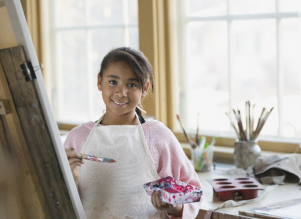8/8/2018
Using Art to Inspire New Ways of Thinking and Learning
In October 2016, an unusual mural went up on an outside wall at P.S. 11 in Brooklyn, New York. When artist Steve Powers put paint to brick at this neighborhood elementary school, the result was a vivid scene full of letters, color, and pictures, with the word “WRITE” spelled out at the bottom. Powers added his own instructional, inspirational messages for the students—one taking the form of a life-size pencil with the words “I am on purpose” written on it—and cleverly built the mural around the first lines from a handful of fiction and nonfiction books slated to be released in 2017.
Up to the challenge
P.S. 11 principal Abidemi Hope signed off on the project, unfazed by the fact that the quotes Powers used were from books meant for adult readers that had themes like “environmental concerns” and “refugees of war.” According to an online article about the mural, Hope felt certain that the school’s 900 students “were up to the challenge of engaging in thought-provoking conversations about the work.”
The mural, which includes brightly colored arrows with the words “Go Fill and Be Fulfilled” painted on them, offers a unique and creative way to support the learning that schools hope to impart to their students. It also reflects the growing emphasis on not only literacy and math instruction, but more comprehensive learning environments such as STEAM, which builds on the much-discussed idea that schools need to focus heavily on helping students gain STEM (science, technology, engineering, math) skills for the 21st century by adding another key piece of the learning puzzle—art.
Picking up STEAM
College students at the Rhode Island School of Design have embraced the concept of making art and design an essential component of today’s classrooms. Working as research assistants, these students have partnered with “teachers, researchers, policy makers, students, and businesspeople” to “apply firsthand knowledge of art and design” to STEM programs through a “STEM to STEAM” project. One of the group’s central case studies comes from two teacher training sessions held in Rhode Island by the Reading is Fundamental program.
Dr. Judy Cheatham, the Reading is Fundamental program's vice president of literacy services, emphasized both the value of literacy and how to use art and design alongside it—particularly when working with low-income students. According to Dr. Cheatham, many of these students do not come from literacy-rich environments, and thus may lack the background knowledge and vocabulary needed to satisfactorily keep up with today’s rigorous academic demands. She noted that books with an art and science emphasis can be especially useful in helping students gain foundational knowledge and set them on the path to increasing their literacy skills.
Dr. Cheatham also highlighted some picture books for younger children, such as Three Hens and a Peacock, which she praised for their “vibrant artwork and creative displays of information.” Art has been positioned as an important “access point” for students and teachers adjusting to the Common Core State Standards, which outline learning targets that often ask kids to think and learn in different and more complex ways. An article in the online journal Edutopia noted that at first, schools were turning to STEM programs as the best way to incorporate Common Core lessons into classrooms. However, writer and arts integration specialist Susan Riley argued that the “arts have unique parallels” to these new standards and can be used to bring out the best in students.
As Riley pointed out, Common Core standards are built around a renewed preference for “process” over “product.” She noted that this is also true in the arts, where students are frequently asked to explore, compare, experiment, and otherwise stretch their thinking in new ways. Riley also drove home the idea that the arts are naturally “engaging” for students and staff alike, and provide opportunities for “true equity” that allow teachers to “ensure that students are learning in a way that meets their own unique cultural, social, emotional and intellectual needs.”
Whether it shows up outside a school or embedded in an important literacy lesson, art can help inspire students to, as artist Steve Powers might say, “Go Fill and Be Fulfilled.”
WHAT DO YOU THINK?
Does your school or district use art to impact student learning? Connect with us on Twitter, Facebook, and LinkedIn and let us know your thoughts and experiences on this topic!


